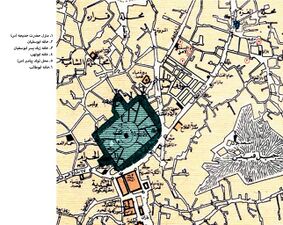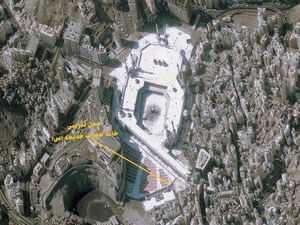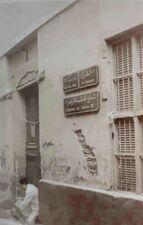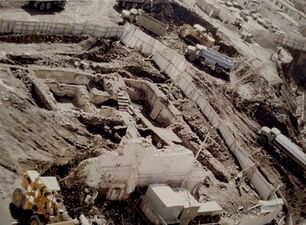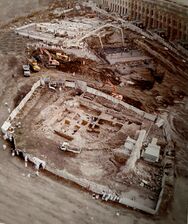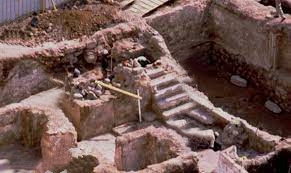Lady Khadija's House: Difference between revisions
No edit summary |
No edit summary |
||
| (3 intermediate revisions by the same user not shown) | |||
| Line 54: | Line 54: | ||
}} | }} | ||
'''Lady Khadija's House''', (Arabic: {{ia|دار السيدة خديجة}}, | '''Lady Khadija's House''', (Arabic: {{ia|دار السيدة خديجة}}, Dār al-Sayyida Khadīja), in [[Mecca]], was the house where the Prophet(s) lived after marrying [[Lady Khadija]] until he migrated to [[Medina]]. This house was the [[Mawlid Fatima|birthplace of Lady Fatima(a)]] and other children of Khadija, and many [[Meccan verses]] of the [[Quran]] were also revealed to the Prophet(s) in that house, and also Khadija died in this house. Since the 6th/12th century, this place has been also known in sources as Lady Fatima's birthplace. Since then, there has been two domes in this house. One was called [[Qubbat al-Wahy]] and it was built on a room that was considered the place of worship of the Prophet(s) and the place where [[Gabriel]] descended on the Prophet. The other dome was built over a room that was said to be Lady Fatima's birthplace. | ||
In the 14th/20th century, after [[House of Saud]] conquered [[Mecca]], this house was destroyed and later a building for teaching the Quran was built in its place. During the demolition and excavation of this place to develop [[al-Masjid al-Haram]] in 1410/1989, the remains of the old building of Khadija's house were found under the soil. This place has disappeared today and its location is in the area of [[al-Masjid al-Haram]]. | In the 14th/20th century, after [[House of Saud]] conquered [[Mecca]], this house was destroyed and later a building for teaching the Quran was built in its place. During the demolition and excavation of this place to develop [[al-Masjid al-Haram]] in 1410/1989, the remains of the old building of Khadija's house were found under the soil. This place has disappeared today and its location is in the area of [[al-Masjid al-Haram]]. | ||
| Line 60: | Line 60: | ||
==Location== | ==Location== | ||
Lady Khadija's house was in Perfumers Alley (Zuqaq al-'Attarin), [[Mecca]].<ref> | Lady Khadija's house was in Perfumers Alley (Zuqaq al-'Attarin), [[Mecca]].<ref>Azraqī, ''Akhbār Makka'', vol. 2, p. 78-87; Yamani, ''Sayyida Khadija bint Khuwaylid'', p. 94.</ref> It was located in the vicinity of [[Abu Sufyan]]'s house.<ref>Azraqī, ''Akhbār Makka'', vol. 2, p. 199.</ref> | ||
This house was the place where the Prophet(s) lived with [[Lady Khadija]]<ref> | This house was the place where the Prophet(s) lived with [[Lady Khadija]]<ref>Azraqī, ''Akhbār Makka'' ,vol. 2, p. 199.</ref> and many [[Meccan verses]] of the Qur'an were revealed in this house.<ref>Fāsī, ''al-Zuhūr al-muqtaṭafa'', p. 99.</ref> [[Fatima(a)]] and other children of Lady Khadija were born in this house.<ref>Azraqī, ''Akhbār Makka'' ,vol. 2, p. 199.</ref> It is also reported that this house is the place of demise of Khadija. The Prophet(s) continued living in this house after that until he migrated to [[Medina]].<ref>Azraqī, ''Akhbār Makka'' ,vol. 2, p. 199.</ref> | ||
==Names== | ==Names== | ||
This house became known as the Dar (house) of [[Lady Khadija]] because of her residence and it was also known as [[Lady Fatima]]'s birthplace because of the birth of Lady Fatima there.<ref> | This house became known as the Dar (house) of [[Lady Khadija]] because of her residence and it was also known as [[Lady Fatima]]'s birthplace because of the birth of Lady Fatima there.<ref>Fāsī, ''al-Zuhūr al-muqtaṭafa'', p. 99.</ref> | ||
==First Descriptions== | ==First Descriptions== | ||
According to Abu l-Walid al-Azraqi, a historian of the third/ninth century, this house was taken over by [['Aqil b. Abi Talib]] after the Prophet(s) migrated to [[Medina]]. [[Mu'awiya b. Abi Sufyan]] bought the house and turned it into a mosque and opened a door to it from Abu Sufyan's house.<ref> | According to Abu l-Walid al-Azraqi, a historian of the third/ninth century, this house was taken over by [['Aqil b. Abi Talib]] after the Prophet(s) migrated to [[Medina]]. [[Mu'awiya b. Abi Sufyan]] bought the house and turned it into a mosque and opened a door to it from Abu Sufyan's house.<ref>Azraqī, ''Akhbār Makka'', vol. 2, p. 199; Ibn Zahīra, ''al-Jāmiʿ al-laṭīf'', p. 286; Kurdī, ''al-Tārīkh al-qawīm'', vol. 1, p. 289.</ref> This house was later called Dar Abi Sufyan.<ref>Kurdī, ''al-Tārīkh al-qawīm'', vol. 1, p. 289.</ref> Elsewhere, al-Azraqi says that the house was occupied by Mu'attib, the son of [[Abu Lahab]], one of the stubborn enemies of the Prophet(s) after his migration,<ref>Ibn Saʿd, ''al-Ṭabaqāt al-kubrā'', vol. 4, p. 45.</ref> but the Prophet(s) did not claim the house after the [[conquest of Mecca]].<ref>Azraqī, ''Akhbār Makka'', vol. 2, p. 245.</ref> | ||
Ibn Jubayr (d. 614/1217-8) mentioned this house in his travelogue at the end of the 6th/12th century. This house had two domes at the time. The larger dome was called the Dome of the Revelation, which was the place where the Prophet(s) used to worship, and the place where Gabriel descended on the Prophet(s), and the other is a small dome, where [[Lady Fatima(a)]] was born.<ref>Ibn Jubayr, | Ibn Jubayr (d. 614/1217-8) mentioned this house in his travelogue at the end of the 6th/12th century. This house had two domes at the time. The larger dome was called the Dome of the Revelation, which was the place where the Prophet(s) used to worship, and the place where Gabriel descended on the Prophet(s), and the other is a small dome, where [[Lady Fatima(a)]] was born.<ref>Ibn Jubayr, ‘’Rihla Ibn Jubayr'', p. 81-82.</ref> | ||
==In the 9th/15th Century== | ==In the 9th/15th Century== | ||
Taqi al-Din al-Fasi (d. 832/1428-9), the historian of Mecca, gave a detailed description of the building of Khadija's house, or according to him "[[Mawlid Fatima]]", and pointed out that this house is considered virtuous by the people and they visit it.<ref> | Taqi al-Din al-Fasi (d. 832/1428-9), the historian of Mecca, gave a detailed description of the building of Khadija's house, or according to him "[[Mawlid Fatima]]", and pointed out that this house is considered virtuous by the people and they visit it.<ref>Fāsī, ''al-Zuhūr al-muqtaṭafa'', p. 99.</ref> | ||
Al-Fasi says this place is more like a mosque because it has a portico with seven arches and eight columns. In the middle of the front wall are three altars; in front of it is a colonnade with four arches and five columns. The other part of the house is the rooms. One is Fatima's birthplace, the other is the [[Qubbat al-Wahy]].<ref> | Al-Fasi says this place is more like a mosque because it has a portico with seven arches and eight columns. In the middle of the front wall are three altars; in front of it is a colonnade with four arches and five columns. The other part of the house is the rooms. One is Fatima's birthplace, the other is the [[Qubbat al-Wahy]].<ref>Fāsī, ''Shifāʾ al-gharām'', vol. 1, p. 360.</ref> Some believe that these rooms are the old area house that was in the time of the Prophet(s) and the mosque was added to it later.<ref>Fāsī, ''Shifāʾ al-gharām'', vol .1 p.360.</ref> The shorter descriptions of other writers are also consistent with al-Fasi's description until the eleventh/seventeenth century.<ref>Yamānī, ''Dār Sayyida Khadīja bint Khūwaylīd'', p. 48.</ref> | ||
==In the 13th/19th and 14th/20th century== | ==In the 13th/19th and 14th/20th century== | ||
In a travelogue from the end of the period of [[Nasir al-Din Shah Qajar]] (R. 1313-1264 AH), it is mentioned in the description of the house of [[Lady Khadija(s)]] that it had a marble floor, a dome was on Lady Fatima's birthplace and a room in it was called the place of the Prophet's worship.<ref> Miqat-i Hajj, Num. 63, p. 70.</ref> According to a report in 1265/1849, in the place of Khadija's house, a [[takiyyah]] known as "Takiyyah al-Sayyida Fatima" was built for the use of the poor.<ref> | In a travelogue from the end of the period of [[Nasir al-Din Shah Qajar]] (R. 1313-1264 AH), it is mentioned in the description of the house of [[Lady Khadija(s)]] that it had a marble floor, a dome was on Lady Fatima's birthplace and a room in it was called the place of the Prophet's worship.<ref> Miqat-i Hajj, Num. 63, p. 70.</ref> According to a report in 1265/1849, in the place of Khadija's house, a [[takiyyah]] known as "Takiyyah al-Sayyida Fatima" was built for the use of the poor.<ref>Kurdī, ''al-Tārīkh al-qawīm'', vol. 1, p. 289-290.</ref> | ||
==Destruction== | ==Destruction== | ||
The Egyptian writer Mohammed Hussein Heikal (d. 1956) visited the place of this house in 1354/1936. He writes: [[Wahhabis]] have destroyed the birthplace of Lady Fatima(s) and now this place is an empty land and there is no trace of it.<ref>Haykal, | The Egyptian writer Mohammed Hussein Heikal (d. 1956) visited the place of this house in 1354/1936. He writes: [[Wahhabis]] have destroyed the birthplace of Lady Fatima(s) and now this place is an empty land and there is no trace of it.<ref>Haykal, ‘’Fī manzil al-waḥy’’, p. 227.</ref> Muhammad Lutfi Jum'a also confirms the destruction of the house in his travelogue.<ref>Lutfi,''ayyam al-mabrurra'', p. 78.</ref> | ||
==Construction of a School of the Quran== | ==Construction of a School of the Quran== | ||
In Jumada I of 1370/1951, a building was built as a school of the Quran on the grounds of Lady Khadija's house.<ref> | In Jumada I of 1370/1951, a building was built as a school of the Quran on the grounds of Lady Khadija's house.<ref>Yamānī, ''Dār Sayyida Khadīja bint Khūwaylīd'', p. 58.</ref> Muhammad Tahir al-Kurdi (d. 1400/1980) has mentioned the building as takiyya.<ref>Kurdī, ''al-Tārīkh al-qawīm'', vol. 1, p. 290.</ref> The building was constructed by Sayyid 'Abbas Qattan and it was known as al-Sayyid 'Abbas's School in Umm al-Mu'minin Khadija's House.<ref>Yamānī, ''Dār Sayyida Khadīja bint Khūwaylīd'', p. 58.</ref> | ||
==Merging with al-Masjid al-Haram== | ==Merging with al-Masjid al-Haram== | ||
At the end of the year 1410/1989, the school of the Quran was destroyed for the eastern expansion of [[al-Masjid al-Haram]]. During the demolition operation, the remains of old building of Lady Khadija's house were excavated.<ref> | At the end of the year 1410/1989, the school of the Quran was destroyed for the eastern expansion of [[al-Masjid al-Haram]]. During the demolition operation, the remains of old building of Lady Khadija's house were excavated.<ref>Yamānī, ''Dār Sayyida Khadīja bint Khūwaylīd'', p. 60.</ref> Ahmad Zaki al-Yamani, was present at the site during the operation and took pictures and maps of the remains of Lady Khadija's house and gave a report of his observations in his book ''Dar Sayyida Khadija bint Khuwaylid''.<ref>Yamānī, ''Dār Sayyida Khadīja bint Khūwaylīd'', p. 93 onwards.</ref> | ||
==Gallery == | ==Gallery == | ||
| Line 101: | Line 100: | ||
file:نقشه خانه حضرت خدیجه(س) 4.JPG|After the latest expansion of the al-Masjid al-Haram | file:نقشه خانه حضرت خدیجه(س) 4.JPG|After the latest expansion of the al-Masjid al-Haram | ||
file:مدرسه حفظ قرآن کریم 1.jpg|Al-Sayyid 'Abbas's school | file:مدرسه حفظ قرآن کریم 1.jpg|Al-Sayyid 'Abbas's school | ||
</gallery> | |||
===Lady Khadijah's House Apearance During Destruction=== | ===Lady Khadijah's House Apearance During Destruction=== | ||
| Line 112: | Line 112: | ||
==Notes== | ==Notes== | ||
{{Notes}} | {{Notes}} | ||
==References== | ==References== | ||
{{References}} | {{References}} | ||
* | * Azraqī, Muḥammad b. ʿAbd Allāh al-. ''Akhbār Makka wa mā jāʾa fī-hā min al-āthār''. Edited by Rushdī Ṣāliḥ Mulḥis. Beirut: 1403AH. | ||
* Fāsī, Muḥammad b. Aḥmad al-Taqī al-. ''Al-Zuhūr al-muqtaṭafa min tārīkh Makka al-musharrafa''. Mecca: Maktaba Nazār Muṣṭafā al-Bāz, 1418AH. | |||
* | * Fāsī, Muḥammad b. Aḥmad al-Taqī al-. ''Shifāʾ al-gharām bi-akhbār al-Balad al-Ḥarām''. Mecca: Maktaba Nazār Muṣṭafā al-Bāz, 1418AH. | ||
* | * Haykal, Muḥammad Ḥusayn. ‘’Fī manzil al-waḥy’’. Cairo: al-Hayʾat al-Miṣrīyya al-ʿĀmma li-l-Kitāb, 2010. | ||
*Haykal, | * Ibn Jubayr, Muḥammad b. Aḥmad. ‘’Rihla Ibn Jubayr''. Beirut: Dār Maktabat al-Hilāl, 1986. | ||
* | * Ibn Saʿd, Muḥammad b. Manīʿ. ''Al-Ṭabaqāt al-kubrā''. Beirut: Dār al-Kutub al-ʿIlmīyya, 1410/1990. | ||
*Ibn | * Ibn Ẓahīra, Muḥammad. ''Al-Jāmiʿ al-laṭīf fī faḍl Makka wa ahl-hā wa bināʾ al-Bayt al-Sharīf''. Cairo: Maktabat al-Thiqāfat al-Dīnīyya, 1423AH. | ||
*Ibn | * Kurdī, Muḥammad Ṭāhir. ''Al-Tārīkh al-qawīm li-Makka wa Bayt Allāh al-karīm''. Beirut: Dār Khiḍr, 1420 AH. | ||
* Yamānī, Aḥmad Zakī. ''Dār Sayyida Khadīja bint Khūwaylīd''. London: Muʾssisat al-Furqān li-l-Turāth al-Islāmī, 1434AH. | |||
* | |||
* | |||
{{end}} | {{end}} | ||
[[fa:خانه حضرت خدیجه(س)]] | [[fa:خانه حضرت خدیجه(س)]] | ||
[[ar:بيت السيدة خديجة(س)]] | [[ar:بيت السيدة خديجة(س)]] | ||
Latest revision as of 08:37, 14 February 2024
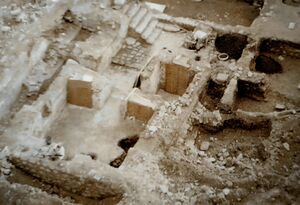 | |
| General Information | |
|---|---|
| Other Names | Mawlid Fatima |
| Place | Mecca, Zuqaq al-'Attarin |
| Religious Aspect | |
| Religious Affiliation | Islam, Shi'a |
| History | |
| Events | Revelation to the Prophet Muhammad(a), birth of Lady Fatima(a) |
| Current State | |
| Status | Destroyed |
Lady Khadija's House, (Arabic: دار السيدة خديجة, Dār al-Sayyida Khadīja), in Mecca, was the house where the Prophet(s) lived after marrying Lady Khadija until he migrated to Medina. This house was the birthplace of Lady Fatima(a) and other children of Khadija, and many Meccan verses of the Quran were also revealed to the Prophet(s) in that house, and also Khadija died in this house. Since the 6th/12th century, this place has been also known in sources as Lady Fatima's birthplace. Since then, there has been two domes in this house. One was called Qubbat al-Wahy and it was built on a room that was considered the place of worship of the Prophet(s) and the place where Gabriel descended on the Prophet. The other dome was built over a room that was said to be Lady Fatima's birthplace.
In the 14th/20th century, after House of Saud conquered Mecca, this house was destroyed and later a building for teaching the Quran was built in its place. During the demolition and excavation of this place to develop al-Masjid al-Haram in 1410/1989, the remains of the old building of Khadija's house were found under the soil. This place has disappeared today and its location is in the area of al-Masjid al-Haram.
Location
Lady Khadija's house was in Perfumers Alley (Zuqaq al-'Attarin), Mecca.[1] It was located in the vicinity of Abu Sufyan's house.[2]
This house was the place where the Prophet(s) lived with Lady Khadija[3] and many Meccan verses of the Qur'an were revealed in this house.[4] Fatima(a) and other children of Lady Khadija were born in this house.[5] It is also reported that this house is the place of demise of Khadija. The Prophet(s) continued living in this house after that until he migrated to Medina.[6]
Names
This house became known as the Dar (house) of Lady Khadija because of her residence and it was also known as Lady Fatima's birthplace because of the birth of Lady Fatima there.[7]
First Descriptions
According to Abu l-Walid al-Azraqi, a historian of the third/ninth century, this house was taken over by 'Aqil b. Abi Talib after the Prophet(s) migrated to Medina. Mu'awiya b. Abi Sufyan bought the house and turned it into a mosque and opened a door to it from Abu Sufyan's house.[8] This house was later called Dar Abi Sufyan.[9] Elsewhere, al-Azraqi says that the house was occupied by Mu'attib, the son of Abu Lahab, one of the stubborn enemies of the Prophet(s) after his migration,[10] but the Prophet(s) did not claim the house after the conquest of Mecca.[11]
Ibn Jubayr (d. 614/1217-8) mentioned this house in his travelogue at the end of the 6th/12th century. This house had two domes at the time. The larger dome was called the Dome of the Revelation, which was the place where the Prophet(s) used to worship, and the place where Gabriel descended on the Prophet(s), and the other is a small dome, where Lady Fatima(a) was born.[12]
In the 9th/15th Century
Taqi al-Din al-Fasi (d. 832/1428-9), the historian of Mecca, gave a detailed description of the building of Khadija's house, or according to him "Mawlid Fatima", and pointed out that this house is considered virtuous by the people and they visit it.[13]
Al-Fasi says this place is more like a mosque because it has a portico with seven arches and eight columns. In the middle of the front wall are three altars; in front of it is a colonnade with four arches and five columns. The other part of the house is the rooms. One is Fatima's birthplace, the other is the Qubbat al-Wahy.[14] Some believe that these rooms are the old area house that was in the time of the Prophet(s) and the mosque was added to it later.[15] The shorter descriptions of other writers are also consistent with al-Fasi's description until the eleventh/seventeenth century.[16]
In the 13th/19th and 14th/20th century
In a travelogue from the end of the period of Nasir al-Din Shah Qajar (R. 1313-1264 AH), it is mentioned in the description of the house of Lady Khadija(s) that it had a marble floor, a dome was on Lady Fatima's birthplace and a room in it was called the place of the Prophet's worship.[17] According to a report in 1265/1849, in the place of Khadija's house, a takiyyah known as "Takiyyah al-Sayyida Fatima" was built for the use of the poor.[18]
Destruction
The Egyptian writer Mohammed Hussein Heikal (d. 1956) visited the place of this house in 1354/1936. He writes: Wahhabis have destroyed the birthplace of Lady Fatima(s) and now this place is an empty land and there is no trace of it.[19] Muhammad Lutfi Jum'a also confirms the destruction of the house in his travelogue.[20]
Construction of a School of the Quran
In Jumada I of 1370/1951, a building was built as a school of the Quran on the grounds of Lady Khadija's house.[21] Muhammad Tahir al-Kurdi (d. 1400/1980) has mentioned the building as takiyya.[22] The building was constructed by Sayyid 'Abbas Qattan and it was known as al-Sayyid 'Abbas's School in Umm al-Mu'minin Khadija's House.[23]
Merging with al-Masjid al-Haram
At the end of the year 1410/1989, the school of the Quran was destroyed for the eastern expansion of al-Masjid al-Haram. During the demolition operation, the remains of old building of Lady Khadija's house were excavated.[24] Ahmad Zaki al-Yamani, was present at the site during the operation and took pictures and maps of the remains of Lady Khadija's house and gave a report of his observations in his book Dar Sayyida Khadija bint Khuwaylid.[25]
Gallery
-
Location in the early Islam
-
After the latest expansion of the al-Masjid al-Haram
-
Al-Sayyid 'Abbas's school
Lady Khadijah's House Apearance During Destruction
Notes
- ↑ Azraqī, Akhbār Makka, vol. 2, p. 78-87; Yamani, Sayyida Khadija bint Khuwaylid, p. 94.
- ↑ Azraqī, Akhbār Makka, vol. 2, p. 199.
- ↑ Azraqī, Akhbār Makka ,vol. 2, p. 199.
- ↑ Fāsī, al-Zuhūr al-muqtaṭafa, p. 99.
- ↑ Azraqī, Akhbār Makka ,vol. 2, p. 199.
- ↑ Azraqī, Akhbār Makka ,vol. 2, p. 199.
- ↑ Fāsī, al-Zuhūr al-muqtaṭafa, p. 99.
- ↑ Azraqī, Akhbār Makka, vol. 2, p. 199; Ibn Zahīra, al-Jāmiʿ al-laṭīf, p. 286; Kurdī, al-Tārīkh al-qawīm, vol. 1, p. 289.
- ↑ Kurdī, al-Tārīkh al-qawīm, vol. 1, p. 289.
- ↑ Ibn Saʿd, al-Ṭabaqāt al-kubrā, vol. 4, p. 45.
- ↑ Azraqī, Akhbār Makka, vol. 2, p. 245.
- ↑ Ibn Jubayr, ‘’Rihla Ibn Jubayr, p. 81-82.
- ↑ Fāsī, al-Zuhūr al-muqtaṭafa, p. 99.
- ↑ Fāsī, Shifāʾ al-gharām, vol. 1, p. 360.
- ↑ Fāsī, Shifāʾ al-gharām, vol .1 p.360.
- ↑ Yamānī, Dār Sayyida Khadīja bint Khūwaylīd, p. 48.
- ↑ Miqat-i Hajj, Num. 63, p. 70.
- ↑ Kurdī, al-Tārīkh al-qawīm, vol. 1, p. 289-290.
- ↑ Haykal, ‘’Fī manzil al-waḥy’’, p. 227.
- ↑ Lutfi,ayyam al-mabrurra, p. 78.
- ↑ Yamānī, Dār Sayyida Khadīja bint Khūwaylīd, p. 58.
- ↑ Kurdī, al-Tārīkh al-qawīm, vol. 1, p. 290.
- ↑ Yamānī, Dār Sayyida Khadīja bint Khūwaylīd, p. 58.
- ↑ Yamānī, Dār Sayyida Khadīja bint Khūwaylīd, p. 60.
- ↑ Yamānī, Dār Sayyida Khadīja bint Khūwaylīd, p. 93 onwards.
References
- Azraqī, Muḥammad b. ʿAbd Allāh al-. Akhbār Makka wa mā jāʾa fī-hā min al-āthār. Edited by Rushdī Ṣāliḥ Mulḥis. Beirut: 1403AH.
- Fāsī, Muḥammad b. Aḥmad al-Taqī al-. Al-Zuhūr al-muqtaṭafa min tārīkh Makka al-musharrafa. Mecca: Maktaba Nazār Muṣṭafā al-Bāz, 1418AH.
- Fāsī, Muḥammad b. Aḥmad al-Taqī al-. Shifāʾ al-gharām bi-akhbār al-Balad al-Ḥarām. Mecca: Maktaba Nazār Muṣṭafā al-Bāz, 1418AH.
- Haykal, Muḥammad Ḥusayn. ‘’Fī manzil al-waḥy’’. Cairo: al-Hayʾat al-Miṣrīyya al-ʿĀmma li-l-Kitāb, 2010.
- Ibn Jubayr, Muḥammad b. Aḥmad. ‘’Rihla Ibn Jubayr. Beirut: Dār Maktabat al-Hilāl, 1986.
- Ibn Saʿd, Muḥammad b. Manīʿ. Al-Ṭabaqāt al-kubrā. Beirut: Dār al-Kutub al-ʿIlmīyya, 1410/1990.
- Ibn Ẓahīra, Muḥammad. Al-Jāmiʿ al-laṭīf fī faḍl Makka wa ahl-hā wa bināʾ al-Bayt al-Sharīf. Cairo: Maktabat al-Thiqāfat al-Dīnīyya, 1423AH.
- Kurdī, Muḥammad Ṭāhir. Al-Tārīkh al-qawīm li-Makka wa Bayt Allāh al-karīm. Beirut: Dār Khiḍr, 1420 AH.
- Yamānī, Aḥmad Zakī. Dār Sayyida Khadīja bint Khūwaylīd. London: Muʾssisat al-Furqān li-l-Turāth al-Islāmī, 1434AH.
